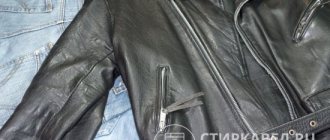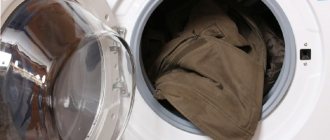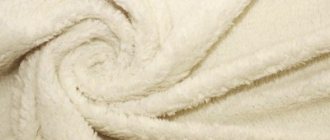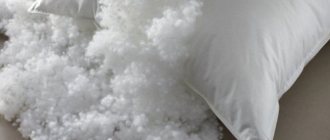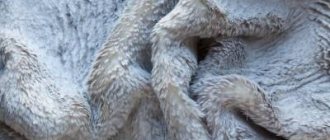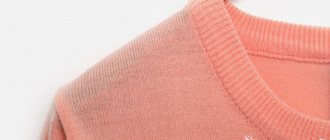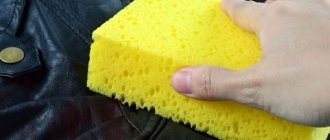If you follow the basic rules for washing suede jackets, you can easily return the products to their original neat appearance without damaging them:
- To maintain the shape of the jacket, be sure to use hangers..
- Drying should take place in natural conditions , and if we are talking about a room, then it should be ventilated, and there should be no heaters near the clothes.
- Suede does not like prolonged contact with water , so the washing process should be quick.
- The water temperature should not exceed 35°.
- It is recommended to use a special cover for washing.
- Suede items are washed separately from others..
General care rules
The main rule for caring for suede items is to avoid serious contamination. Be careful when wearing light-colored clothing. Vacuum newly purchased items to remove dust that has settled during their production and transportation. Brushing should be done regularly to prevent dirt from accumulating.
The second thing to remember about the material is that it does not like to be over-wetted, so before deciding to wash, read the label, or better yet, clean it by hand. It is better to dry things at a sufficient distance from heating devices so that they do not lose their quality and beauty. It is better to place the product on hangers and leave it on the balcony.
Drying and ironing
Proper care of faux suede clothing includes mandatory adherence to recommendations for drying and ironing products:
After washing, the material must not be twisted. Things should be placed above the basin or placed on the bottom of the bathtub, and the water should be allowed to drain freely.- Excess moisture can be blotted with a towel. Another option: lay the clothes horizontally on a terry sheet, roll them, and gently wring them out.
- It is better to dry suede in a horizontal position in the fresh air or in a well-ventilated area. In a closed bathroom, the material will not dry out and will acquire a musty smell.
- Wet clothes should be protected from direct sunlight and radiators, and should not be taken out onto the balcony during frost.
- To maintain their shape, hats, gloves, bags, and shoes must be filled with crumpled paper or newspapers during drying, changing them as moisture is absorbed.
- Faux suede can only be ironed from the reverse side with a warm iron. To protect the material, it is worth placing a special ironing net or thin cloth.
If there are deep creases or folds, it is better to steam the clothes. After treatment, you need to walk over the entire surface with a dry brush to remove moisture and lift the pile.
Preparing for cleaning
Suede is considered one of the finicky materials, but it is quite easy to clean. The main thing is to know and apply the general rules, stock up on a specialized brush for suede products. The structure of fabrics is varied, so first study the manufacturer’s data presented on the label.
Before processing, the jacket should be inspected by laying it out on a flat surface. Then they carry out a moisture tolerance test by wetting a small area of it. After a quarter of an hour, the result will be visible: if the condition of the material has not deteriorated, the jacket is cleaned.
To clean a suede jacket at home, you can use the tools that any housewife has in her arsenal. You need to arm yourself:
- a special brush;
- hydrogen peroxide;
- ammonia;
- baking soda;
- table vinegar.
Powder or liquid detergent for wool products is also suitable for this purpose.
Remove dirt
The detergent used for washing must be selected with special care, since ordinary washing powder, used in most cases, is not suitable for these purposes. It is recommended to use gels and other liquid products for washing, because they are easily washed out of the fabric and do not settle in it.
Powders that are diluted to a paste can easily remove dirt. You can also use laundry soap as a gentle product. But you should not use bleach to wash a light jacket, as it can damage the product.
Shampoo or leather cleaner can also be used for washing. These components will not only carefully clean the product, but also give it softness. This good property is very useful, since it is undesirable to use rinse aids during washing.
It is necessary to remove contaminants from the material immediately before washing, since otherwise they can either spread throughout the entire product or not be removed at all. The second option is more common, and therefore you should find in advance a means that will cope with a certain type of pollution, and this requires action locally.
You can clean the collar, pockets and areas near the buttons of a suede jacket using a product such as an eraser. The easiest way to deal with salinity is ammonia, as well as starch. However, to increase efficiency, it is recommended to wait a few hours. You should not use stain removers for these purposes, as they can ruin the appearance of the item.
Faux suede
The synthetic analogue of natural suede is sensitive to excess moisture, so dry cleaning is recommended. Delicate washing is possible where permitted by the manufacturer. Warm water (30 °C) is poured into the prepared container, a suede jacket is lowered into it and carefully cleaned.
Then the product is thoroughly washed, avoiding twisting and friction. Dry it on hangers so that its shape does not deform.
Dry cleaning is provided for items that are not recommended to be washed. Treatment is carried out using brushes or rags pre-moistened in cleaning solutions. Ethyl alcohol and an aqueous solution of ammonia (6 drops per 250 ml of liquid) effectively combat stains.
Natural suede
Natural suede can be cleaned dry or wet. The material is washed by hand in water whose temperature does not exceed 45 °C. Use laundry soap and products for wool and silk products for cleaning.
You can properly clean a natural suede jacket at home, if you follow a number of rules.
- It is forbidden to soak the product - clean it with a damp brush or rag.
- The material must be processed carefully so that it does not shrink in size.
- Natural suede should be rinsed exclusively in warm water.
- A solution of glycerin (1 tsp) and water (1 l), which is used to rub the product, will help prevent the material from becoming coarser.
- The treated jacket is rolled into a tube so that the product penetrates better into the material.
Dry cleaning methods
If you don’t trust traditional methods, use ready-made products or entrust the product to professionals. Special sprays, impregnations, and coloring aerosols are produced for suede.
Chemicals
Industrial suede cleaning products are sold in shoe stores. Special powders, sprays, impregnations collect dirt, renew the pile, and restore color.
Dry cleaning
If the stains are old, ingrained or of unknown origin, it is better to take the suede jacket to the dry cleaner. Professionals use special products and have the necessary equipment to process suede.
Light suede
Light-colored clothes, especially outerwear, get dirty faster than dark ones, so they require more careful handling. One of the most popular means for cleansing it is low-fat milk (250 ml); it is also worth preparing 1 tsp. baking soda and hydrogen peroxide (1-2 drops).
All components are mixed, a piece of fabric (flannel or wool) is moistened with the substance and applied to the contaminated areas. After all stains are removed, suede clothing is rinsed in water and dried.
A light-colored item can also be cleaned with a mixture of peroxide (1 tsp) and ammonia (1 tsp), which is dissolved in a glass of water. Next, perform the same cleaning procedure as with the milk formula.
It is not necessary to wait until your outerwear becomes heavily soiled. You can carry out preventative cleaning several times a season.
Dark suede
Cleaning dark suede requires just as much attention as light suede. If done incorrectly, the item may lose not only its shape, but also its color. You can bring your outerwear into proper shape without ruining it by following a number of rules.
Main recommendations:
- the treatment is carried out with products intended for leather items;
- Machine washable at temperatures less than 35 °C and minimum speed;
- hand washing is carried out with a soft brush with short bristles;
- It is better to dry the product on a hanger so that it does not lose its shape.
Removing the gloss
Outerwear acquires a greasy sheen in areas of greatest friction. There are several ways to remove greasy stains from suede.
- Salt. It is poured onto a fresh stain. It disappears after a couple of hours.
- Dentifrice. It is applied to the newly contaminated area, and after 1-2 hours the suede is treated with a brush.
- Ammonia. A solution (6 drops per 250 ml of water) applied to the product helps to effectively clean suede from greasy stains. Then the treated areas are thoroughly washed and dried.
- Starch. It is mixed with ammonia, applied to the stain and washed off after a while.
- Laundry soap. The contaminated area is first treated with soap, then washed with water and alcohol in a ratio of 4:1. Add 1 tsp to 1 liter of water. table vinegar, wash clothes in it, then rinse and dry.
- Table vinegar. Helps clean the product from smudges left by rain or snow.
The case should be considered when only a certain area of outerwear is contaminated. Then there is no need to completely clean it.
The most common places where greasy stains appear are the sleeves and collar. The method of dealing with this problem is quite simple and includes several methods, before using which the areas of contamination are steamed.
- The steamed area is treated with a hard bristle brush, after which it is wiped with a damp cloth, rinsed and dried with a dry cloth.
- Cover the greasy stain with a mixture of starch and talc and clean it with a brush after 60 minutes.
- Treat the stain with a solution of gasoline and turpentine in a 2:1 ratio. After this, it will disappear on its own over time. This method should be used as a last resort when other options are ineffective.
Removing stains
To remove minor stains from clothes or shoes made of artificial suede, you can use folk remedies:
- Fat. Fresh drops should be covered with starch, baby powder, and crushed chalk. After 15–30 minutes, brush off the product and carefully wash the damaged area with a cotton pad and soap solution.
- Juice, grass, pollen, any stains of organic origin can be wiped off with a cloth moistened with vinegar (9%).
- Wine. A fresh stain should be blotted with a dry, clean cloth. To remove dried marks, use a thick soap solution or shaving foam. The product should be applied to the stain, left for half an hour, and the residue removed with a napkin.
- Gum. Rub the sticky mass with an ice cube. When the gum hardens, carefully remove it from the fabric.
- Dirt. Do not touch wet drops; you must wait until they dry. Then clean the damaged area with a brush.
- Glue, varnish, traces of cosmetics . Gently rub the marks with a cloth moistened with nail polish remover without acetone.
A universal safe remedy for any contamination is ordinary laundry soap. By whipping soap shavings into a thick foam, you can treat the greasy area, remove stains, dry clean, wash things by hand or put them in the drum of a washing machine.
To revive shiny areas, you need to:
treat them with a school eraser, a crust of rye bread, a nail file or pumice;- Apply a layer of wet coffee grounds (without sugar, milk, aromatic additives) to brown items, leave for 15 minutes, remove with a brush;
- Clean white shoes, gloves or a bag with a sponge and dry tooth powder or baking soda;
- extensive damage should be treated with an aqueous solution of ammonia (2:1), then rinsed with running water.
After removing the stain, the material should be dried thoroughly, and then the pile should be lifted with a clothing or toothbrush. If a noticeable mark or stains remain, the clothes will have to be washed completely or taken to the dry cleaner.
Spray paint for suede will help disguise heavily damaged areas. The main thing is to choose the right color.
Updating the pile
Suede does not always require deep cleaning; sometimes it is enough to update its pile. Steaming is considered the simplest and most affordable way to bring things into proper shape at home.
You can carry out the procedure using a regular kettle, which needs to be brought to a boil. Start steaming a suede jacket from the dirtiest places, holding them over steam. After processing the entire product, its pile is straightened with a brush. This method allows you to quickly return your favorite item to a presentable appearance.
Wash
It is preferable to clean suede products by hand, but machine washing is not excluded. It is carried out only after careful preparation of outerwear. Study the manufacturer's recommendations, which are indicated on the label.
If such an option is provided, then proceed to choosing a cleaning product. It should be soft and intended for suede items. The washing machine is switched to delicate mode with a temperature of no more than 35 °C, and spinning and automatic drying should be canceled.
Suede outerwear can also be washed by hand. To do this, you need to pour warm water into a basin, add a special liquid product and prepare a soft brush. Suede is sensitive to moisture, so the jacket is made quickly.
Rinsing will take some time, since this procedure will require 2-3 approaches. This must be done until the liquid becomes clear. After this, the item is carefully straightened and dried on a flat surface or on hangers.
Cleaning the lining
In most cases, the lining gets dirty the fastest and therefore requires cleaning more often. This happens due to constant contact with human skin, as well as his things. A large amount of sweat settles on the lining, as well as perfume and other contaminants. Why wash a product completely if it doesn’t need it?
If the lining is removable, it is recommended to simply wash it separately from the jacket in the washing machine. Otherwise, you will have to contrive and carry out the procedure more carefully. It is recommended to use for these purposes a regular soap solution prepared on the basis of washing powder. It must be applied using a sponge. It is also worth being careful in this matter and not allowing soapy water to get on the suede, as this may leave streaks on the jacket.
At the rinsing stage, it is recommended to add a small amount of table vinegar to the water. After processing, you need to blot the lining with a dry material to remove excess moisture. If you need to wash not only the lining, but also the product itself as a whole, then you should start processing with the lining, and then move on to the main material, since in this case, even if the soap solution gets on the suede, you can remove the stains.

